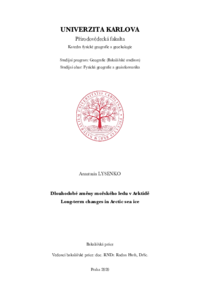Dlouhodobé změny mořského ledu v Arktidě
Long-term changes in Arctic sea ice
bachelor thesis (DEFENDED)

View/
Permanent link
http://hdl.handle.net/20.500.11956/120399Identifiers
Study Information System: 210019
Collections
- Kvalifikační práce [20809]
Author
Advisor
Referee
Margold, Martin
Faculty / Institute
Faculty of Science
Discipline
Physical Geography and Geoinformatics
Department
Department of Physical Geography and Geoecology
Date of defense
2. 9. 2020
Publisher
Univerzita Karlova, Přírodovědecká fakultaLanguage
Czech
Grade
Very good
Keywords (Czech)
klimatická změna, mořský led, teplota, trendy, ArktidaKeywords (English)
climatic change, sea ice, temperature, trends, ArcticPráce shrnuje znalosti o mořském ledu v Arktidě, jeho vlastnostech, podmínkách a procesu vzniku. Popisuje také klima Arktidy a jeho změny od počátku 20. století. Práce ukazuje, jak a proč je arktický mořský led důležitý pro klima celé naší planety, a že klimatický systém je velmi propojený. To znamená, že pokud například dojde k zásadním změnám mořské ledové pokrývky nebo změnám klimatu, tak se vliv těchto změn může projevit i v úplně jiné oblasti, což je projevem tzv. kaskádového bodu zvratu. Proto se tato práce také dotýká tématu zpětných vazeb a ukazuje, že stanovení množství a typu mořského ledu v Severním ledovém oceánu je zásadní pro zlepšení našich znalostí a pochopení polárního počasí a dlouhodobých výkyvů klimatu. Klíčová slova: klimatická změna, mořský led, teplota, Arktida
The thesis summarizes the knowledge of sea ice in the Arctic, its properties, conditions and the process of formation. It also describes the Arctic climate and its changes since the early 20th century. The work shows how and why Arctic sea ice is important for the climate of our entire planet and that the climate system is highly interconnected. This means that if, for example, there are fundamental changes in the sea ice cover or climate, then the impact of these changes may manifest itself in a completely different area, which is a manifestation of the so- called cascading tipping point. Therefore, this work also touches on the topic of feedback and shows that determining the amount and type of sea ice in the Arctic Ocean is essential to improve our knowledge and understanding of polar weather and long-term climate fuctuations. Key words: climatic change, sea ice, temperature, Arctic
